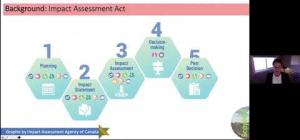
Health impact assessments
A health impact assessment (HIA) is a process that strategically evaluates the potential effect on health of a policy, plan or project. The assessment generally takes place in a series of steps, each using a mixture of procedures and tools that provide decision makers and stakeholders with information about the intended and unintended consequences arising from an activity. The process may also result in recommendations to maximize positive and mitigate negative health impacts for affected populations (World Health Organization, 2021). HIAs may be conducted as part of environmental and other assessments or on a stand-alone basis and are recognized as an instrument that can support frameworks such as Health in All Policies (St. Pierre 2017). In Canada, HIA practice has been guided by the determinants of health approach and the World Health Organization's holistic definition of health:
"… a state of complete physical, mental and social well-being and not merely the absence of disease or infirmity" (Health Canada, 2004).
Public health professionals may be involved in one or more steps of an HIA (e.g., screening, scoping, assessment, recommendation, reporting, and monitoring and evaluation). Canada requires environmental assessments for many types of undertakings under federal, provincial, territorial, and municipal legislation, but until 2019, health assessments were not universally required except in the province of Quebec under its Public Health Act of 2002 (Gagnon, Turgeon, & Clemence, 2008). With the passage of the Federal Impact Assessment (IA) Act on August 28, 2019, this situation changed (Government of Canada, 2019). The Practitioner's Guide related to this Act outlines the manner in which health criteria are to be included in IAs (Government of Canada, 2020). The main requirements are that best practices in HIA must be employed, and the Public Health Agency of Canada's recommendation to apply the social determinants of health approach should be followed (Government of Canada, 2020).
The resources listed here are intended to assist public health practitioners to:
- Understand what HIAs are and the contexts in which they may be used;
- Outline the steps, methods, and tools used to conduct an HIA;
- Provide examples of how HIAs influence projects, plans, and policies; and
- Provide case studies and guides relevant for the Canadian context.
For examples of provincial and territorial requirements for EAs, see: BC, AB, SK, MB, ON, QC, NL, NB, NS, PEI, YT, NT, NU. Current documents related to federal requirements can be found on the Impact Assessment Agency of Canada's website
NCCEH resources
- Health in impact assessments for natural resource and large infrastructure developments-Opportunities for public health (Freeman 2021)
This blog post discusses changes under Canada's Impact Assessment Act 2019 that may affect the practice of HIA and the role of public health professionals in the assessment of natural resource and large infrastructure development.
- Scoping Population Health in Impact Assessment (ScopHIA) (Brown and Nykiforuk, 2021)
This guest blog post introduces the findings of a realist review on opportunities to promote health equity during the planning phase of federally mandated impact assessments in Canada.
- Scoping Population Health in Impact Assessment (ScopHIA) Realist Review (Brown and Nykiforuk)
This webinar presents the findings of a realist review identifying best practices for health equity in scoping major resource developments and large-scale infrastructure projects.
- NCCEH Health impact assessment knowledge and needs scan
The report presents the findings of a 2019, national scan of public health professionals regarding their involvement in HIA. The finding from of an online survey and key informant interviews are presented together with the main insights gained on HIA practice, skills, challenges, and recommendations for meeting these through training and other measures.
- Incorporating health in urban planning: Quebec City case study (Diallo 2019)
This blog post describes the collaborative process involving a regional public health agency, municipal stakeholders, an NGO and researchers in applying HIA in urban planning projects in Quebec City between 2014 and 2019.
- The paradox of wealth and health: Resource development and social determinants of health (Oke and Aalhus 2019)
This webinar presents the evidence on the impact of natural resource development on the social determinants of health and summarizes options for best practice based on the experience of BC's Northern Health's Office of Health and Resource Development.
- Widening the health lens in the environmental impact assessment process: lessons learned in the George Massey Tunnel replacement project (2017)
This webinar used the George Massey Tunnel replacement project to showcase how an HIA delves deeper into potential health issues created by a project, compared to a standard environmental health assessment.
- Incorporating health into environmental assessments in Canada (Peterson and Kosatsky, 2016)
This article discusses why health (e.g., physical, economic, and social determinants of health) needs to be consistently included in environmental assessments, and makes suggestions of what public health practitioners can do to effectively incorporate health into environmental assessments.
- Putting health in environmental assessment (2015)
A panel was held at the Canadian Institute of Public Health Inspectors National Conference. Its purpose was to provide a basic understanding of the importance of including health in environmental assessments. Slide decks from three presenters are included.
- Health impact assessment in environmental health: methods, tools, and policy change (2012)
This workshop presents a theoretical basis of HIAs, including an HIA overview and steps to conduct an HIA, various HIA tools, and how HIA can influence policy. Slide decks from six presenters are included.
Selected external resources
General background, guides, and courses
- Practitioner's Guide to Federal Impact Assessments under the Impact Assessment Act (Impact Assessment Agency of Canada, 2020)
This guide provides instruction for stakeholders involved in Canadian IA. Sections relevant for PH professionals outline the implementation of Public Health of Canada recommendations regarding the Determinants of Health, HIA to assessing baseline health conditions (sections 1.2, 1.3) and potential health impacts from the proposed project (section 5.1), and monitoring criteria once a project is operating.
- Scoping Population Health in Impact Assessment Realist Review: Identifying Best Practices for Equity in Scoping of Major Natural Resource and Large-Scale Infrastructure Projects (Brown et al. 2020)
This report addresses the inclusion of health criteria in the IA process under Canada's new IA Act. The findings of 185 sources are synthesized, and recommendations are made for the planning phase of the IA process.
- Health Impact Project (The Pew Charitable Trusts, 2020)
This project webpage contains a range of documents including case studies, a practitioner survey, and evidence-informed guidance and tools.
- Online Course-Health Impact Assessment, step by step (National Collaborating Centre for Healthy Public Policy, 2019)
This nine-module, self-guided, online course aims to familiarize participants with the HIA process. The target audience includes public health practitioners interested in understanding the fundamentals of HIA for public policies, the steps of a high-quality HIA and the favourable conditions for successful HIA implementation.
- Public Health and Environmental Assessments (Ontario Public Health Association 2018-9)
This four-part webinar series introduces public health professionals to the environmental assessment process and the role of public health within the process. The series includes case studies in integrated transportation planning, health assessment within environmental assessment and steps for the effective engagement of the public health sector.
- Health impact assessment (World Health Organization, 2017)
This webpage offers a wealth of HIA resources, from basic HIA information, tools and methods, HIA for policy change, HIA networks, to examples of HIAs across various sectors (e.g., agriculture, mining, tourism etc.).
- Health equity impact assessments: Situational and resource analysis (Alberta Health Services, 2017)
This purpose of this report is to provide decision-making information for the development of health equity impact assessment (HEIA) to help relevant AHS partners embed a health equity lens into their planning, development, implementation, and evaluation activities. An extensive literature review and overview of assessment types is included.
- Health Considerations in Impact Assessment (Viliani, 2017)
This presentation provides a high level, international overview of HIA practice with a focus on local communities, health impacts and their determinants. Numerous Canadian and international examples are provided. Particular attention is given to distinguishing health from social assessments, the timing of incorporating health aspects and the role of health experts and triggers for HIA.
- Health impact assessment: a guide for the oil and gas industry (International Petroleum Industry Environmental Conservation Association, 2016)
This guide presents the perspective of the oil and gas sector, highlighting the purpose of conducting an HIA and outlining the six step HIA process.
- Health impact assessment (HIA) of transportation and land use activities: guidebook and toolkit (Metro Vancouver, 2015)
This webpage includes downloadable PDF versions of both the HIA guidebook and toolkit. The guidebook provides a background and introduction to HIA as well as tools and resources. The toolkit provides checklists and questions for each step in the process and a tool to help complete an HIA terms of reference.
- Health impact assessment (National Collaborating Centre for Healthy Public Policy, 2015)
This webpage provides information on the foundations of HIA, and its growing popularity in Canada and internationally. Links on the page present numerous resources e.g., HIA basics; guides and tools such as a cost calculator, screening grid, and scoping tools; options for continuing education in HIA; upcoming HIA events; and case studies.
- Health in impact assessments: opportunities not to be missed (World Health Organization, 2014)
This publication provides a balanced view on five different types of impact assessments (environmental, strategic environmental, social, sustainability, and health impact assessments). It uses four key questions to examine how these assessments protect human health.
Case studies
- Growing Healthier: A Health Equity Impact Assessment for Saskatoon’s Growth Plan. (Sharpe et al. 2016)
This report applies a health equity lens to the City of Saskatoon’s Growth Plan. It focuses on community health and well-being within the context of land-use and transportation planning (with an emphasis on public transit and active transportation). It develops 13 recommendations that are compatible with the core initiatives of the Growth Plan.
- Health Impact Assessment of the TOD Neighbourhood Project in Sainte-Catherine. Report on potential impacts and recommendations (Tremblay et al. 2014)
This report presents the results from an HIA conducted for a residential, Transit-Oriented Development (TOD) in the Montreal suburb, Sainte-Catherine. The analyses and recommendations focus on aspects of the project that are likely to affect a number of health determinants, including the configuration of public roadways and other project elements that can encourage or discourage use of active modes of travel, such as walking and cycling.
Peer-reviewed publications
- Liveability as determinant of health: Testing a new approach for health impact assessment of major infrastructure. (Browne & Lowe 2021)
This paper elaborates a framework for scoping health impacts of large urban infrastructure projects by incorporating 11 determinants of health using an Australian case study for the replacement of a level railway crossing with an elevated track.
- Quantitative health impact assessment methodology for societal initiatives: A scoping review (Reumers et al. 2021)
This scoping review assesses quantitative HIAs applied to community based initiatives with particular attention to methods and health indicators used to measure health outcomes.
- A Comparative Analysis of Health Impact Assessment Implementation Models in the Regions of Montérégie (Québec, Canada) and Nouvelle-Aquitaine (France) (2020)
This paper describes two case studies of HIA applied to planning and uses the comparative framework to draw insights on opportunities, challenges and keys to successfully systematically including health criteria in municipal planning.
- An adaptable Health Impact Assessment (HIA) framework for assessing health within Environmental Assessment (EA): Canadian context, international application (McCallum et al., 2018)
This study addresses the need for a consistent and transparent method for HIA, and develops an assessment framework designed to: (1) accommodate HIA as a stand-alone process and when integrated with environmental assessments; (2) harmonize language used in HIA and environmental assessment processes; and, (3) devise a system to evaluate impacts resulting from multiple determinants of health.
- Community participation in health impact assessment. A scoping review of the literature (den Broeder et al., 2017)
This review article shows that community participation in an HIA has many benefits, such as the empowerment of communities, and perceived improved relations between communities and local agencies.
- Health impact assessment for health promotion, education and learning (Harris-Roxas & O’Mullane, 2017)
This article introduces a special issue of the journal, Global Health Promotion containing seven articles, each focusing on HIA applied to one of urban and transportation planning, waste management, climate policy, and equity.
- An evaluation of health impact assessments in the United States, 2011 – 2014 (Bourcier et al., 2015)
This review article examined multiple HIAs conducted over a five year period, to conclude that HIAs are a useful tool in promoting public health. Factors that increased HIA success, as well as challenges encountered, are discussed.
- Advancing the practice of health impact assessment in Canada: obstacles and opportunities (McCallum et al., 2015)
This review article examines the use of HIA in Canada. It identifies six areas for further improvement and development of HIA methods to increase HIA uptake in Canada, especially in light of Canada’s history of natural resource development.
This list is not intended to be exhaustive. Omission of a resource does not preclude it from having value.








